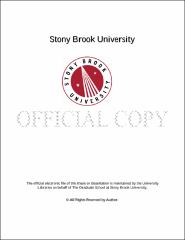| dc.identifier.uri | http://hdl.handle.net/11401/77737 | |
| dc.description.sponsorship | This work is sponsored by the Stony Brook University Graduate School in compliance with the requirements for completion of degree. | en_US |
| dc.format | Monograph | |
| dc.format.medium | Electronic Resource | en_US |
| dc.language.iso | en_US | |
| dc.publisher | The Graduate School, Stony Brook University: Stony Brook, NY. | |
| dc.type | Dissertation | |
| dcterms.abstract | This dissertation enhances our understanding of the nature of emphatics and their effects on neighboring vowels through a large-scale acoustic study of emphasis in Zilfaawi Arabic. Based on data from 15 male speakers of Zilfaawi, the acoustic correlates of emphasis are shown to be F2 drop and F1 increase, which can extend across entire disyllabic words when emphatics appear in word-initial and word-final positions. Because of lowering the second formant and raising the first one, I argue that emphasis is expressed as a pharyngealization process produced by backing the tongue root towards the pharynx. Furthermore, I show that the effect of emphasis on neighboring segments is phonetic (using the criteria proposed by Zawaydeh 1999), as evidenced by the effect's gradient decline with distance, the lack of blocking by high vowels and consonants, and the lack of blocking by morpheme boundaries. I also show that emphatics affect stressed and unstressed vowels equally. Finally, I offer a constraint-based analysis of emphatic effect as it applies to /a/, /i/, and /u/, adopting the framework developed by Flemming (2001) which uses universal weighted constraints and implements phonetic representations associated with phonetic dimensions such as F2. I demonstrate how such a system can handle the complex interaction of phonological and phonetic goals when vowels and emphatics interact. The amount of emphatic effect exerted on vowels differs from one vowel quality to another. The high vowels /i/ and /u/ are the least affected vowels while the low vowel /a/ is the most affected one; I attribute the smaller effect on /i/ to the conflict between the acoustic requirements of /i/, low F1 and high F2, and the opposite requirements of the emphatics. With regard to the smaller effect on /u/, I attribute this to the vowel's inherently low F2, which is already in agreement with the requirements of the emphatics. Finally, /a/ is most affected because it does not have an opposing (high F2) goal, nor does it already have a low F2 target. It is my hope that this analysis of Zilfaawi Arabic will be one step towards comparisons between this dialect and other dialects of Arabic, on the one hand, and between Arabic and other languages, on the other, all working toward the goal of better understanding of how knowledge of speech sounds is represented and used in human language. | |
| dcterms.available | 2017-09-20T16:53:28Z | |
| dcterms.contributor | Huffman, Marie | en_US |
| dcterms.contributor | Becker, Michael | en_US |
| dcterms.contributor | Hoberman, Robert | en_US |
| dcterms.contributor | Lababidi, Zafer. | en_US |
| dcterms.creator | Alammar, Ammar | |
| dcterms.dateAccepted | 2017-09-20T16:53:28Z | |
| dcterms.dateSubmitted | 2017-09-20T16:53:28Z | |
| dcterms.description | Department of Linguistics | en_US |
| dcterms.extent | 234 pg. | en_US |
| dcterms.format | Monograph | |
| dcterms.format | Application/PDF | en_US |
| dcterms.identifier | http://hdl.handle.net/11401/77737 | |
| dcterms.issued | 2017-05-01 | |
| dcterms.language | en_US | |
| dcterms.provenance | Made available in DSpace on 2017-09-20T16:53:28Z (GMT). No. of bitstreams: 1
Alammar_grad.sunysb_0771E_13265.pdf: 71885324 bytes, checksum: d5c35163ce49d2b34f25085ad17eda86 (MD5)
Previous issue date: 1 | en |
| dcterms.publisher | The Graduate School, Stony Brook University: Stony Brook, NY. | |
| dcterms.subject | Arabic, Emphasis, Emphatics, Pharyngealization, Phonetics | |
| dcterms.subject | Linguistics | |
| dcterms.title | Emphasis in Zilfaawi Arabic | |
| dcterms.type | Dissertation | |

